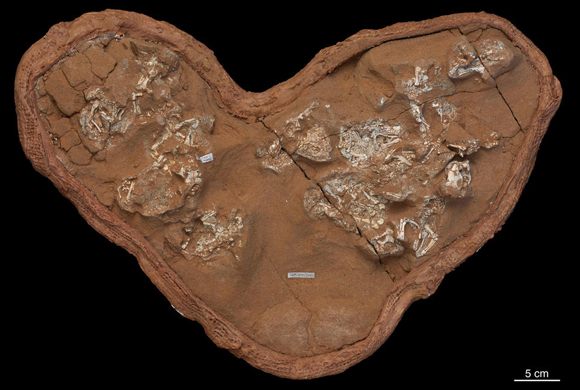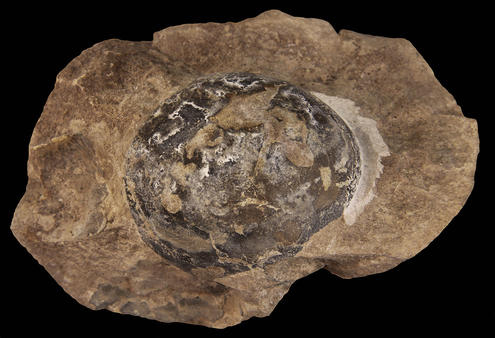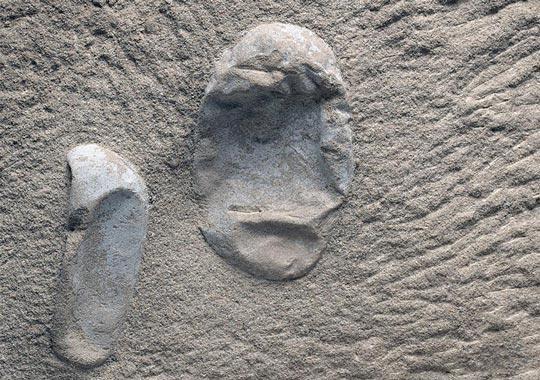The First Dinosaur Eggs were Soft
The First Dinosaur Eggs were Soft like a Turtle’s
The scientific paper has a succinct title, but the repercussions for vertebrate palaeontologists are seismic. This week has seen the publication in the journal Nature of a paper entitled “The first dinosaur egg was soft”. Palaeontologists have inferred and implied a great deal about dinosaur reproduction, but the assumption had been that, just like living archosaurs today, the crocodiles and birds, dinosaurs laid hard-shelled eggs.
Dr Mark Norell (American Museum of Natural History) and his co-authors propose that calcified, hard eggshells were not the “default setting” for the Dinosauria, the first dinosaur eggs were soft-shelled like those of a turtle or a snake. In addition, the researchers conclude that hard-shelled, calcified eggs evolved at least three times independently within the Dinosauria.
Protoceratops Protects a Nest from a Marauding Oviraptorosaur
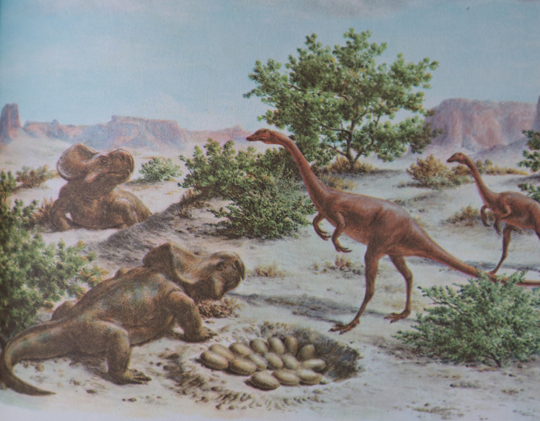
Picture credit: Everything Dinosaur (from Zalinger)
Unscrambling Dinosaur Eggs
The research led by the American Museum of Natural History in collaboration with colleagues from Yale University, Universidad de Buenos Aires (Argentina), Montana State University, University of Calgary (Canada) and the Museo Paleontológico Egidio Feruglio, Trelew, (Argentina), applied a series of sophisticated geochemical techniques to analyse the eggs of two different non-avian dinosaurs. They discovered that the eggs resembled those of extant turtles in their composition, microstructure and mechanical properties.
Commenting on the significance of this research, corresponding author Mark Norrell stated:
“The assumption has always been that the ancestral dinosaur egg was hard-shelled. Over the last 20 years, we’ve found dinosaur eggs around the world. But for the most part, they only represent three groups – theropod dinosaurs, which includes modern birds, advanced hadrosaurs like the duck-billed dinosaurs and advanced sauropods, the long-necked dinosaurs. At the same time, we’ve found thousands of skeletal remains of ceratopsian dinosaurs, but almost none of their eggs. So why weren’t their eggs preserved? My guess – and what we ended up proving through this study, is that they were soft-shelled.”
Ceratopsian Eggs Were Probably Soft-shelled and This Explains their Rarity in the Fossil Record
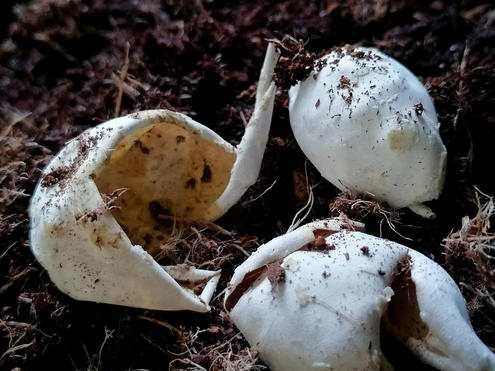
Picture credit: Jasmina Wiemann (Yale University)
Calcified Eggshells – An Evolutionary Hedge Against Environmental Stress
The amniotes, a group of tetrapods that includes the mammals, birds and the reptiles all produce eggs with an inner membrane, known as the amnion. This inner membrane helps to prevent the embryo from drying out. Some amniotes such as many turtles and squamates (lizards and snakes), lay soft-shelled, leathery eggs, whilst others such as birds and crocodilians produce eggs with a heavily calcified shell. It is thought that these calcified eggs help to protect the developing embryos inside the eggs from environmental stresses, thus giving the calcified egg layers an evolutionary advantage.
The evolution of the hard-shelled egg is seen as a major step in the global dominance of the amniotes, it leading to greater reproductive success for those members of this group that developed this trait.
The Eggs from a Member of the Theropoda (Domestic Chicken)
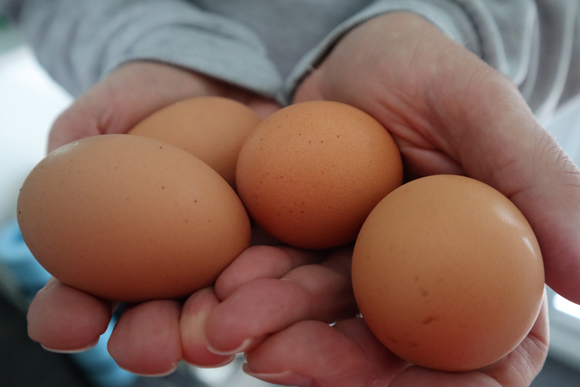
Picture credit: Everything Dinosaur
The Fossil Record Shows Bias in Favour of Calcified Eggs
Soft-shelled eggs rarely preserve in the fossil record. It is very likely that ancient turtles laid soft-shelled eggs, just like their modern counterparts, but such evidence is hard to find in the fossil record. The same could be inferred for other amniotes, they too might have laid soft-shelled eggs but such evidence would be very difficult to find. Therefore, studying the transition from soft-shelled eggs to biomineralised, calcified eggs is a substantial challenge for palaeontologists. As birds and extant crocodilians lay hard-shelled eggs, this type of eggshell has been inferred for all the non-avian dinosaurs.
Protoceratops and Mussaurus
The research team undertook an intensive study of two fossil egg specimens appertaining to two very different dinosaurs – the neoceratopsian Protoceratops (P. andrewsi), known from the Upper Cretaceous Djadokhta Formation exposed in the Gobi Desert of Mongolia and Mussaurus (M. patagonicus) from the Upper Triassic-aged El Tranquilo Formation located in southern Argentina. The beautifully preserved Protoceratops fossils include a clutch of at least a dozen eggs with embryos, half of which preserve nearly complete skeletons. Most of the Protoceratops embryos are preserved in a posture in which their vertebrae and limbs are flexed, synonymous with a posture adopted by animals still inside their eggs.
The Protoceratops (P. andrewsi) Nest Fossil
Picture credit: M. Ellison (American Museum of Natural History)
Some of the skeletal material is obscured by a black and white egg-shaped halo. In contrast, two potentially recently hatched Protoceratops in the fossil specimen are largely free of this mineral halo. The research team analysed tiny slices of this halo material using a petrographic microscope. Further analysis was undertaken using Raman microspectroscopy, where light scattered by a high powered laser provides information on the molecular composition of a sample. The scientists discovered chemically altered trace residues of the proteinaceous eggshell membrane that makes up the innermost layer of the eggshell of extant archosaurs. Almost identical results were observed when the Mussaurus specimen was examined.
The Fossilised Remains of the Mussaurus Egg
Picture credit: Diego Pol (Museo Paleontológico Egidio Feruglio, CONICET)
Comparing Biomineralisation Residue Signatures
The research team which included Diego Pol (Museo Paleontológico Egidio Feruglio CONICET), Darla Zelenitsky (University of Calgary) and Jasmina Wiemann (Yale University) then compared the data from the fossil material to eggshell data from other living amniotes such as turtles, birds, lizards and crocodiles. They determined that the Mussaurus and the Protoceratops eggs were non-biomineralised and therefore they would have resembled the leathery, soft-shelled eggs of living turtles.
Graduate student Jasmina Wiemann explained:
“It’s an exceptional claim, so we need exceptional data. We had to come up with a brand-new proxy to be sure that what we were seeing was how the eggs were in life and not just the result of some strange fossilisation effect. We now have a new method that can be applied to all other sorts of questions, as well as unambiguous evidence that compliments the morphological and histological case for soft-shelled eggs in these animals.”
Creating a “Supertree” to Track Eggshell Evolution
In total, data from 112 extinct and living amniotes was analysed by the research team. This enabled them to build a “supertree” to track the phylogeny of egg-shell evolution over geological time. They concluded that the ancestors of the Dinosauria probably produced an egg that lacked a calcified layer, that these animals laid soft-shelled eggs and that the first, true dinosaurs had the same type of egg.
This element of the research suggests that calcified, hard-shelled eggs evolved independently at least three times throughout the Mesozoic era in the Dinosauria, explaining the bias towards eggshells of derived dinosaurs in the fossil record. The calcified layer of eggshell evolved independently in ornithischian, sauropodomorph and theropod dinosaurs.
Co-author Matteo Fabbri (Yale University) added:
“From an evolutionary perspective this makes much more sense than previous hypotheses, since we’ve known for a while that the ancestral egg of all amniotes was soft. From our study, we can also now say that the earliest archosaurs, the group that includes dinosaurs, crocodiles and pterosaurs had soft eggs. Up to this point, people just got stuck using the extant archosaurs – crocodiles and birds to understand dinosaurs.”
Implications for the Pterosauria
This research has implications for the Pterosauria clade. Pterosaur eggs are exceptionally rare, a fossil of the wukongopterid (Darwinopterus modularis), reveals the outline of a single egg inside the body cavity. The egg confirms that the pterosaur fossil represents a female that was gravid when she died. More significantly, scientific papers detailing extensive fossil remains associated with the debris from a nesting colony of the pterosaur Hamipterus tianshanensis have been published and the three-dimensionally preserved eggs do resemble the leathery soft-shelled eggs now associated with members of the Dinosauria.
Fossilised Eggs of Hamipterus tianshanensis – Could They have the Same Biomineralisation Profile of Soft-shelled Dinosaur Eggs?
Picture credit: Xinhua/Wang Xiaolin
To read our 2017 blog post about the Hamipterus colony: Hamipterus Nesting Ground Discovery.
To read our recent article about the discovery of a giant soft-shelled egg associated with a marine reptile: It’s Not a Deflated Football, it’s Probably an Egg from a Mosasaur.
Everything Dinosaur acknowledges the assistance of a media release from the American Museum of Natural History in the compilation of this article.
The scientific paper: “The first dinosaur egg was soft” by Mark A. Norell, Jasmina Wiemann, Matteo Fabbri, Congyu Yu, Claudia A. Marsicano, Anita Moore-Nall, David J. Varricchio, Diego Pol and Darla K. Zelenitsky published in the journal Nature.
The Everything Dinosaur website: Everything Dinosaur.


